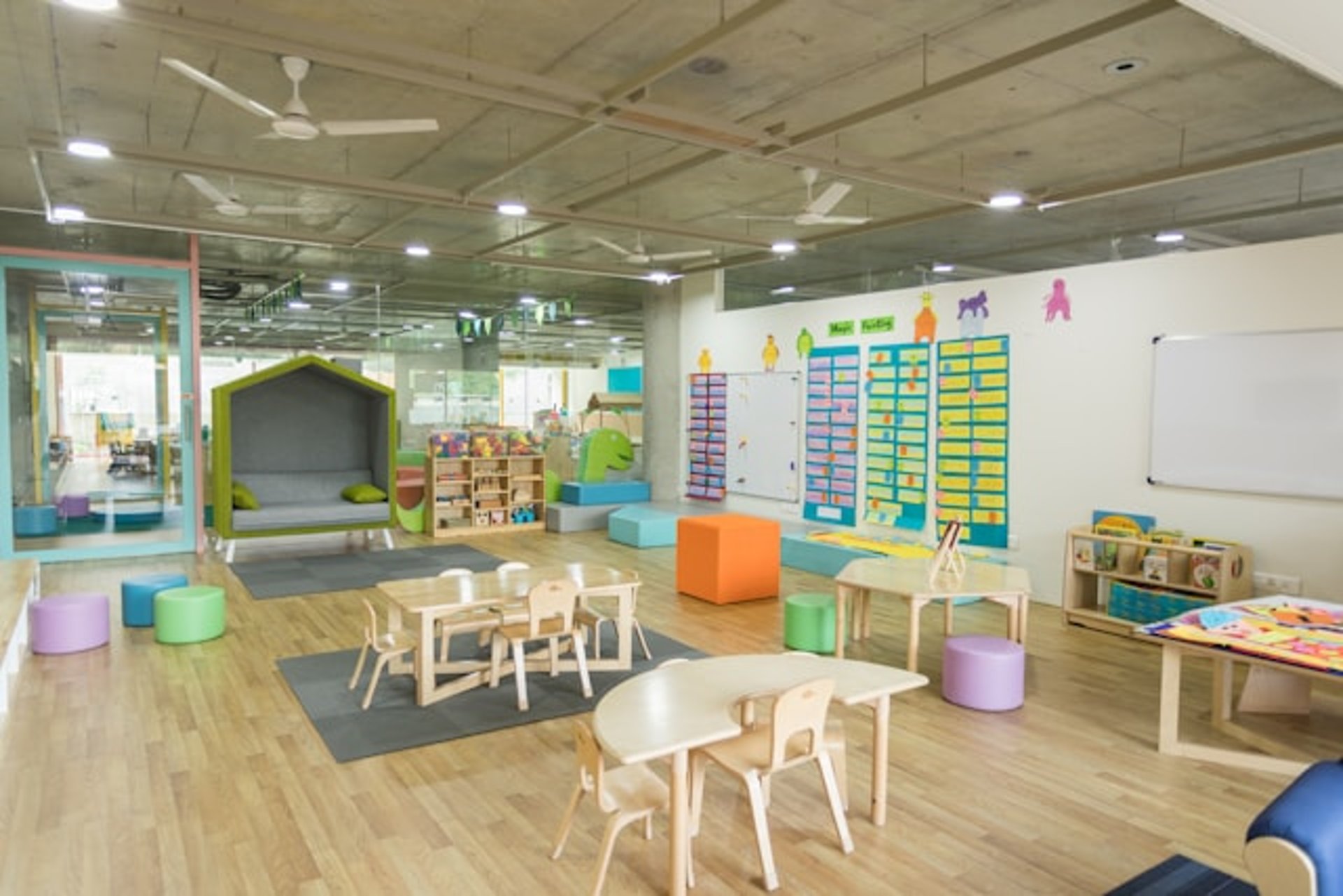How to Create a Tech-Friendly Learning Area in a Preschool Classroom
Ready to create a tech-friendly learning area? Get smart tips, classroom layout ideas, and lesson plans that make technology part of everyday learning.
EDUCATION
6/5/20255 min read

10 Tips to Create a Tech-Friendly Learning Area in Your Preschool Classroom
You use technology every day, so it makes sense to help your preschoolers feel comfortable with it in ways that support their learning and growth. The best part is that you don’t need to be a tech expert to create a space where preschoolers feel excited to learn with digital tools.
When introduced in natural yet playful ways, technology can become a powerful tool for sparking curiosity and developing important early skills. Sure, it will take some planning and intention on your part to build a tech-friendly area in your classroom but the rewards are worth the effort. The goal isn't to fill the day with screen time, but to introduce simple tools that create engaging, age-appropriate learning experiences and help young children explore, express, feel, and think in new ways.
You might be working in a larger early childhood center or running your own preschool. Perhaps, you homeschool your toddler(s). In either case, this guide offers tips to help you build a space where children can explore, learn, and grow and at the same time, become comfortable with the technology they’ll see all around them as they grow older.
Here are 10 simple tips to help you design a classroom tech area that’s fun, safe, and full of learning opportunities.
1. Think about why you want to use technology.
Before setting up any devices, take a moment to think about how you want technology to help your students. Do you want to build stronger language skills? Maybe you’d like to explore science topics in new ways or encourage problem-solving through games. When you know your goals, it becomes easier to choose the right apps and tools. Technology works best in the classroom when it has a clear purpose behind it.
2. Create little tech corners for group time.
Instead of one big station, try setting up a few small tech corners. You could have a tablet loaded with educational games in one area, a digital camera setup in another, and a listening spot with headphones somewhere nearby. These small stations make it easier for children to work together, take turns, and share ideas. You’ll also get to observe how they interact, which can give you helpful insights into their learning styles.
3. Pick tools that are just right for young learners.
When choosing devices, look for ones that suit preschoolers’ little hands and short attention spans. Tablets with simple touch screens and sturdy cases are a good place to start. Avoid anything with tiny buttons or hard-to-navigate menus. Try apps that encourage storytelling, drawing, or problem-solving. These keep kids interested and give them a chance to explore ideas in their own way.
4. Connect tech to the themes you’re already teaching.
You don’t need to create a whole new curriculum just to use technology. Try weaving it into what you’re already doing. If your theme is “weather,” let children take photos of clouds or use an app that shows different seasons. This helps them see how tech fits into the world they know. When it’s tied to a familiar theme, technology feels like a natural part of their learning.
5. Keep hands-on play in the mix.
It’s important that technology doesn’t take over the day. Children still need time to paint, build, dig in the sand, and move their bodies. Try pairing digital activities with real-world play. For example, if they draw animals in an app, offer animal figures or art supplies nearby. This mix of tech and hands-on play keeps the day interesting and supports all areas of development.
6. Make the tech area easy to reach and use.
Set up your devices where kids can reach them on their own. Use child-safe headphones and sturdy covers to protect everything. It’s also a good idea to talk about how to use devices gently. Children can learn how to carry a tablet with care or put away headphones when they’re done. These little habits help them feel more confident and responsible.
7. Use tech to support talking and listening.
Look for apps that involve stories, songs, or simple conversation games. Children can listen, sing along, or even record their voices. When they play with others, they learn how to take turns, ask questions, and explain their ideas. These are important steps in building communication skills. You can also use digital stories as a starting point for group discussions or creative projects.
8. Try simple digital tools for exploration.
Technology can help kids look closer and notice new things. You might try using a digital microscope to look at leaves or bugs, or let them take pictures of shadows and patterns outside. These tools give children a different way to ask questions and discover new ideas. You can build on their interests by adding related books, crafts, or group activities.
9. Keep things fresh by switching it up.
Every few weeks, try adding something new to the tech area. You could introduce a drawing app one week and a simple math game the next. Changing things up keeps children interested and gives you a chance to see which tools work best. If an app sparks excitement and creativity, you’ll know it’s worth keeping around.
10. Make the space cozy and inviting.
A tech area doesn’t have to feel cold or clinical. Add cushions, soft rugs, or a nearby reading corner to make it feel more like the rest of your classroom. Use warm lighting and soft colors so children feel relaxed and ready to explore. A calm, comfortable space helps them feel at ease when trying new things.
A Few Sample Lesson Ideas for Your Tech Area
Below, we’ve shared a few lesson plans to give you a head start as you begin to shape your own ideas for tech-based learning. These technology activities give children chances to observe, create, and interact in different ways. You may add one into your weekly routine or rotate them based on what your group is most excited about. The choice is yours!
What's important is that having a few ready-made ideas will make your weekly planning smoother and also help you notice how kids respond to different formats. Apart from that, these lessons support early exploration and give children new opportunities to express what they notice and wonder about.
Nature and Technology
Goal: Encourage observation and support language development.
Tools: Tablets with nature apps, magnifying glasses, cameras
Activity: Take a short nature walk. Let children collect leaves or small rocks. Use the camera to snap photos. Back in class, explore the items using a nature app. Talk about what they see and help them describe each item.
Telling Stories with Digital Tools
Goal: Support creativity and social skills.
Tools: Storytelling apps, drawing tools
Activity: Children listen to a short digital story. Then they draw their favorite part using an app. Invite them to show their picture to the group and explain it in their own words.
Intro to Coding Through Play
Goal: Practice early STEM thinking and planning.
Tools: Simple coding toys, tablet with sequencing app
Activity: Show children a coding toy and explain how it moves. Let them figure out how to get it from one spot to another. You can also use an app that teaches basic step-by-step thinking.
Wrapping Up
So, you see, it doesn't require a lot to build a tech-friendly learning area that feels inviting and supports your preschoolers’ growth. The key is to set clear goals from the get-go, choose age-appropriate tools, and complement screen time with hands-on activities. Use technology that feels natural in your classroom, inspires early childhood learners to ask questions, and make your classroom a place where curiosity and learning thrive.
If you’ve been searching for ideas to bring technology into your preschool classroom, you’re in the right place. This guide is just the beginning, though!
Explore
Welcome to Stay Curious – the blog where questions never get old and answers are always a little bit unexpected. Here, we challenge the status quo, dig into the weird and wonderful, and offer insights that might just make you think, “Why didn’t I know this sooner?”
From quirky facts to deep dives into the everyday mysteries of life, we’re all about satisfying that itch for knowledge you didn’t even know you had.
So, go ahead—stay curious. We promise it’ll be worth your while. Or, you know, not.
Contribute
Learn
ask.staycurious@gmail.com
© 2025. All rights reserved.
We welcome guest posts on business, tech, travel, finance, lifestyle, career, relocation, and home improvement. Submissions must be original, unpublished (online), at least 800 words, and written in English.
Ready to contribute? Contact us with your ideas!
